 Image search results - "mikoshi" Image search results - "mikoshi" |

This is early in the morning when the 54 portable shrines who had gathered in front of the shrine depart for the procession one after another.
|
|

In front of Tomioka Hachimangu Shrine on Eitai-dori road.
|
|
|
|

As the mikoshi depart, there is some entertainment at the Tomioka Hachimangu Shrine.
|
|

Taiko drummers at Tomioka Hachimangu Shrine.
|
|

In front of the shrine, a shrine priest blesses each portable shrine as it departs to join the procession.
|
|

The portable shrines are paraded through a route which will take them almost all day to complete, from 7:30 am to 3 pm.
|
|

The mikoshi are splashed with water in whichever way possible. This is in the middle of summer, so it's a good way to cool off.
|
|

Each mikoshi is preceded by a row of women carrying lanterns and wands. Also see the video at YouTube
|
|

People in happi coats carry the mikoshi while shouting "Wasshoi, wasshoi!"
|
|
|

Standard uniform of portable shrine bearers (for both men and women).The headband may be tied at the front or back of the head. It may also be tied on the head like a bonnet. There is a variety of ways of tying the headband.
The happi coat bears the name of the parish or district the person belongs to. The same name is displayed on the respective portable shrine. The shorts are white and skintight. Worn by both men and women. Also called Han-momo or Han-momohiki. The white tabi (sock-like shoe) has a rubber sole.
|
|
|

Portable shrines
|
|
|

"Hey Ho, Let's Go!"
|
|
|
|

This mikoshi is being carried by all women, already soaked to the bone. They carry the mikoshi flat on their shoulders. This is called "Hira katsugi," literally "flat carrying."There are four basic methods of carrying a portable shrine. This is the most basic method where they carry it flat on their shoulders. This is called "Hira katsugi," literally "flat carrying."
|
|
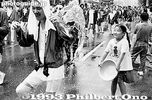
Splash you. This is a day when kids can be mean to grown-ups. This little girl kept filling up her bowl and ran around splashing some unlucky person.I hope that's her school teacher.
|
|

Water splashing truck near Kiyosu-bashi Bridge
|
|

Water hose at Kiyosu-bashi Bridge
|
|

Crossing Kiyosu-bashi Bridge over Sumida River.
|
|

Crossing Kiyosu-bashi Bridge
|
|

Crossing Kiyosu-bashi Bridge
|
|

Raising the mikoshi on Kiyosu-bashi Bridge
|
|

Crossing Kiyosu-bashi Bridge. They chant "wasshoi wasshoi!" as they carry the mikoshi. 清洲橋
|
|

Crossing Kiyosu-bashi Bridge
|
|
|

With raised arms, this is one way to carry the mikoshi.
|
|

A horde of people follow each portable shrine.
|
|
|
|

The portable shrine (mikoshi) passes through Hie Shrine's torii to join the procession. 神輿
|
|
|

Phoenix atop a portable shrine.
|
|

Kiyosu-bashi Bridge over the Sumida River, Important Cultural Property 清洲橋 国の重要文化財
|
|

Crossing over Eitai-bashi Bridge. 永代橋
|
|

Mikoshi
|
|
|
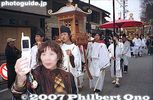
A middle-aged woman uses her camera phone to photograph herself. "I was here!"
|
|
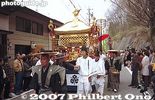
Portable shrine 神輿
|
|

Portable shrine 神輿
|
|

A portable shrine crosses Eitai-bashi Bridge.
|
|

A portable shrine crosses Eitai-bashi Bridge.
|
|

A mikoshi arrives at Hie Shrine.
|
|

Another portable shrine crosses Eitai-bashi Bridge.
|
|

They pass through the ring.
|
|

Using a water hose is an efficient way to get people wet. But see what the big boys use..
|
|

In front of the shrine, the priest blesses the mikoshi portable shrine.
|
|

A fire hose. The local fire department with a fire hose on Eitai-dori avenue.
|
|

The portable shrines came one after another.
|
|

The water hose is now handled by volunteers, not real firemen.
|
|
|
|

Every time, the water hoses are at the same location.
|
|
|
|

Water spray
|
|
|
|

Portable shrine 御羽車
|
|
|
|
|

Crowd on Eitai-dori road
|
|
|

After crossing Eitai-bashi Bridge, the portable shrines headed for the main stretch on Eitai-dori avenue already filled with people. The wettest and most crowded part of the festival is held along this one kilometer of road between the bridge and shrine.
|
|

Quite a spectacle.
|
|
|
|
|
|
|

Hie Shrine Sanno Matsuri
|
|

This is the final stretch and wettest part of the festival.
|
|
|

Prepared for the water...
|
|
|
|
|

A large truck filled with water with people using buckets to splash water in rapid succession.
|
|

View from behind the "water truck." This goes on for about 15 seconds. The truck is refilled with a fire hose. All in the name of purification.
|
|

Portable shrine housing the spirit of Sugawara Michizane. This is the most important thing in the procession. 御鳳輦
|
|

During a break, two kids get water.
|
|
|
|
|
|

Fukagawa Hachiman Matsuri, mizu-kake
|
|

The mikoshi is raised high as they all bathe in water. Taking photos like this one requires adequate water protection of your camera and lens.
|
|
|

Onegaishimasu! お願いします!
|
|

Hai, OK (ha-ha!).
|
|

For some reason, it's fun to see people get wet...
|
|

Getting wet upside down might be an extra thrill...
|
|

In front of the water truck. Soon to be filled with people and a portable shrine.
|
|
|
|
|

Wet women
|
|

Large crowd watch the mikoshi parade near Tomioka Hachimangu Shrine on Eitai-dori road.
|
|
|
|

As the portable shrines reach the shrine, they give one last show before returning to their parish.
|
|

The portable shrine gets a final mid-air toss while passing by Tomioka Hachimangu Shrine. This mid-air toss of the portable shrine is called "mai-age" or tossing up.
|
|

One after another, the mikoshi arrives in front of the shrine.
|
|

And give their last show.
|
|
|
|
|

Being at the shrine's torii entrance is a great place to watch the mikoshi.
|
|
|
|
|
|
|
|
|
|
|
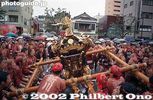
Dramatic display of mikoshi maneuvers
|
|
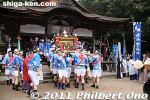
At around 11:30 am, the two mikoshi portable shrines leave the shrine.
|
|
|
|
|
|
|
|
|
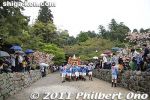
Leaving the shrine. The procession is headed by the two mikoshi.
|
|
|
|
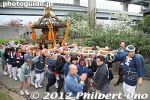
A portable shrine was carried around the park.
|
|
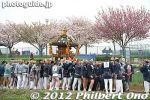
Parading a mikoshi portable shrine in the park. Beyond those trees is Arakawa River.
|
|
|
|

Mikoshi amid rapeseed blossoms.
|
|
|
|

Portable shrine bearers pose for photo.
|
|
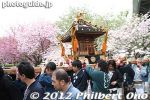
Still carrying around the mikoshi.
|
|
|
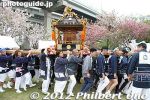
Mikoshi portable shrine and cherry blossoms.
|
|
|
|
|
|

On the Koshu Kaido main road, they started a mikoshi (portable shrine) procession from 5 pm on the third day.
|
|

Mikoshi bearers
|
|

All-female mikoshi bearers.
|
|

Koshu Kaido is filled with people during the mikoshi procession.
|
|
|
|
|
|
|
|

The Hyozu Matsuri is held at Hyozu Taisha Shrine during May 3-6, but the 5th is the climax with the mikoshi parade. This is the shrine's first torii. This is at the front end of a 300-meter pine tree-lined path. Infrequent buses go to the shrine from Yasu Station (North exit). So infrequent that you might need to take a taxi. 一の鳥居
|
|

There is the 300-meter, pine tree-lined gravel path to the shrine from the first torii. MAP
|
|

A Shinto ceremony is held at the shrine in the morning. Then by noon or so, over 30 portable shrines and taiko drums gather here on this path for the annual Hyozu Matsuri on May 5.
|
|

When I visited this shrine before, I wondered what these stone markers were for. Now I know. They have the name of a portable shrine, indicating the place where the respective portable shrines can be parked along this path during the festival.
|
|

At the end of the pine tree path, the second torii is red, right after the Taikobashi Bridge.
|
|

When I arrived, the Ayame girls were rehearsing their routine for the festival in front of this red Romon Gate. This gate was said to have been donated by Shogun Ashikaga Takauji in the 14th century. 楼門
|
|

"Ayame" means iris flower, in reference to women. Out of the 30+ portable shrines (mikoshi) and taiko drums to be paraded during the festival, two of them, called Ayame, are carried only by women. These women will carry the Ayame mikoshi and tai
|
|
|

Ayame girls rehearsing their festival call.
|
|

Ayame girls at Hyozu Matsuri.
|
|
|
|

At the festival start time, the Ayame girls start carrying the taiko drum and mikoshi from this gate.
|
|
|
|

It was a beautiful festival day on May 5, 2010. The Ayame girls wore colorful happi coats which really added color to the festival.
|
|
|

After the taiko drum, a second group of girls start carrying the Ayame mikoshi.
|
|
|
|
|

They crossed over the Taikobashi Bridge. あやめ神輿
|
|

They leave here and proceed along the pine tree path to the first torii. Then they will come back here and go back and forth a few times during the festival.
|
|
|
|
|
|

A set routine is lowering and raising the mikoshi.
|
|
|
|
|
|

Many of the mikoshi are for children. The mikoshi come from smaller shrines in the area related to Hyozu Taisha.
|
|

There are several large mikoshi carried by men. All the mikoshi and taiko drums have a name.
|
|
|

They shout "Choitosa!" while carrying the mikoshi. チョイトサ
|
|
|
|
|
|
|
|
|
|

One mikoshi was missing. Maybe it was lost.
|
|

At this end of the pine tree path, there is the Taikobashi Bridge and the red torii. This is where the crowd is concentrated to see the mikoshi being raised and the phoenix atop the mikoshi pulled out and raised by the mikoshi rider..
|
|
|

One feature of this festival is that someone rides on the mikoshi and detaches and raised the phoenix ornament at the top of the mikoshi.
|
|
|
|
|
|
|
|

Looking toward Hyozu Taisha Shrine.
|
|

A unique thing about this festival is that the mikoshi rider pulls out and raises the mikoshi's top ornament (usually a phoenix). 鵜の息抜き
|
|
|
|
|
|
|
|
|
|
|
|
|
|
|
|
|
|
|
|

They come one after another, big and small.
|
|
|
|
|
|
|
|
|
|

All that gravel can make it quite dusty.
|
|
|
|

The lost mikoshi.
|
|
|

The drummer really has to move quickly with the rest of the boys as they move unpredictably.
|
|
|
|
|
|
|
|
|
|
|
|
|
|
|
|
|
|

Almost got run over by this one.
|
|
|
|
|

The big Omiya mikoshi.
|
|
|
|

The Ayame girls return.
|
|

Nice to see a few foreigners too. Local English teachers perhaps.
|
|

I often see foreigners participating in Shiga festivals.
|
|
|
|
|
|
|
|
|
| 899 files on 4 page(s) |
1 |
 |
|